Albany, Georgia
Albany is a city in the U.S. state of Georgia. Located on the Flint River, it is the seat of Dougherty County. Located in southwest Georgia,[6] it is the principal city of the Albany, Georgia metropolitan area. The population was 77,434 at the 2010 U.S. Census, making it the eighth-largest city in the state.[2]
Albany, Georgia | |
|---|---|
City | |
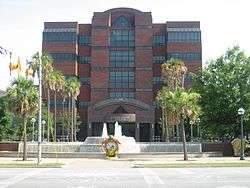 The Albany, Georgia Government Center | |
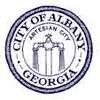 Seal | |
| Nicknames: The Good Life City, The Artesian City, Egypt Of America | |
| Motto(s): "There's only one Albany, Georgia" | |
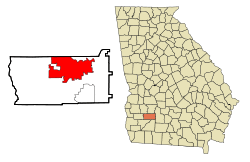 Location in Dougherty County and Georgia | |
 Albany Location in Dougherty County and Georgia  Albany Albany (the United States) 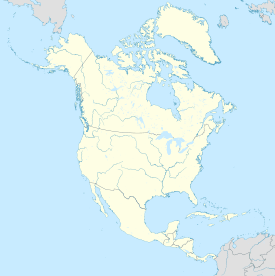 Albany Albany (North America) | |
| Coordinates: 31°34′56″N 84°9′56″W | |
| Country | United States |
| State | Georgia |
| County | Dougherty |
| Incorporated (city) | December 27, 1838 |
| Government | |
| • Mayor | Bo Dorough |
| Area | |
| • City | 55.83 sq mi (144.59 km2) |
| • Land | 55.06 sq mi (142.62 km2) |
| • Water | 0.76 sq mi (1.97 km2) |
| Elevation | 203 ft (62 m) |
| Population | |
| • City | 77,434 |
| • Estimate (2018)[3] | 75,249 |
| • Density | 1,366.55/sq mi (527.63/km2) |
| • Urban | 77,434 |
| • Metro | 157,308 (US: 258th) |
| Demonym(s) | Albanian |
| Time zone | UTC−5 (EST) |
| • Summer (DST) | UTC−4 (EDT) |
| ZIP code(s) | 31701, 31705, 31707, 31721, 31763 |
| Area code(s) | 229 |
| FIPS code | 13-01052[4] |
| GNIS feature ID | 0310424[5] |
| Website | www.albanyga.gov |
It became prominent in the nineteenth century as a shipping and market center, first served by riverboats and then by railroads. Seven lines met in Albany, and it was a center of trade in the Southeast. It is part of the Black Belt, the extensive area in the Deep South of cotton plantations. From the mid-20th century, it received military investment during World War II and after, that helped develop the region. Albany and this area were prominent during the civil rights era, particularly during the early 1960s as activists worked to regain voting and other civil rights. Railroad restructuring and reduction in the military here caused job losses, but the city has developed new businesses.
History
The region where Albany is located was long inhabited by the Creek Indians, who called it Thronateeska after their word for "flint", the valuable mineral found in beds near the Flint River. They used it for making arrowheads and other tools.[7] In 1830 Congress passed the Indian Removal Act, and the United States made treaties to extinguish Creek and other Native American land claims in the Southeast. The US Army forcibly removed most of the native peoples to Indian Territory, lands west of the Mississippi River.
Nelson Tift
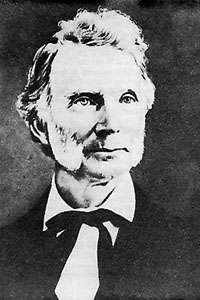
European-American settlement began with Nelson Tift of Groton, Connecticut, who took land along the Flint River in October 1836 after Indian removal. Tift and his colleagues named the new town Albany after the capital of New York; noting that New York's Albany was a commercial center located at the headwaters of the Hudson River, they hoped that their town near the headwaters of the Flint would prove to be just as successful. It proved to be nowhere near as prosperous. Alexander Shotwell laid out the town in 1836, and it was incorporated as a city by an act of the General Assembly of Georgia on December 27, 1838.[8]
Tift for decades was the city's leading entrepreneur. An ardent booster, he promoted education, business, and railroad construction. During the Civil War he provided naval supplies and helped build two ships. He opposed Radical Reconstruction inside the state and in Congress, and was scornful of the Yankee carpetbaggers who came in. Historian John Fair concludes that Tift became "more Southern than many natives."[9] His pro-slavery attitudes before the war and his support for segregation afterward made him compatible with Georgia's white elite.[9]
This area was developed for cotton cultivation by planters, who used numerous enslaved African Americans to clear lands and process the cotton. As a result of the planters' acquisition of slave workers, by 1840 Dougherty County's majority population was black, composed overwhelmingly of slaves. The market center for cotton plantations, Albany was in a prime location for shipping cotton to other markets by steamboats on the river. In 1858, Tift hired Horace King, a former slave and bridge builder, to construct a toll bridge over the river. King's bridge toll house still stands.
Already important as a shipping port, Albany later became an important railroad hub in southwestern Georgia. Seven lines were constructed to the town. An exhibit on trains is located at the Thronateeska Heritage Center in the former railroad station.
Carey Wentworth Styles
After the war, Carey Wentworth Styles moved to Albany and founded the newspaper Albany News. In the early years following the war, Styles, like Tift, took great exception to the Radical Reconstruction program then in force, and advocated for a more moderate response based on his interpretation of Georgia's rights under the Constitution.[10] Styles backed "constitutional reconstruction" advanced by Benjamin H. Hill and sought support for the idea from the national Democratic party.[10][11] While on a trip to Atlanta in May 1868, to meet with Democratic party leaders, Styles took measure of the contemporary Atlanta newspapers, and found them lacking.[12] Styles believed them to be little more than organs for the Radical Republican reconstruction agenda.[13][14] He resolved to bring a paper aligned with the Democratic party viewpoint to the Atlanta market, one supporting his constitutional reconstruction ideals.[11][12][13][14] Styles moved from Albany to Atlanta, and on May 9 he announced that he had obtained the necessary financial backing to purchase the Daily Opinion.[15] On June 16, 1868 the new Democratic daily (as he described it) printed its first edition, under the name The Constitution.[12] Styles' tenure at the Atlanta Constitution would be brief. Unable to pay for his portion of the purchase, when the sale of his Albany News fell through, Styles was forced to surrender his interest in the paper to his joint venture partners. Styles returned to Albany as editor of the News. In 1872, he was elected to the Georgia Senate, representing Augusta and surrounding communities, in an ironic turn of events, having killed a member of the Georgia House of Representatives in his earlier years.[10][11][16] After his legislative service, Styles sold the Albany newspaper in 1876 and returned to Atlanta.
20th century to present
While integral to the economic life of the town, the Flint River has flooded regularly. It caused extensive property damage in 1841 and 1925. The city has also been subject to tornadoes. On February 10, 1940, a severe tornado hit Albany, killing eighteen people and causing large-scale damage.
On April 11, 1906, the Carnegie Library, created by matching funds from the philanthropist Andrew Carnegie, was opened downtown. Originally a segregated facility under Jim Crow laws, it was not open to African Americans until after the passage of the Civil Rights Act of 1964. It functioned as a library through 1985. In 1992, after renovation, the building was reopened as the headquarters of the Albany Area Arts Council.
In 1912, the downtown U.S. Post Office and courthouse building opened. Other federal projects have been important to the city and region. In 1937, Chehaw Park was constructed as a part of a New Deal program under the administration of President Franklin D. Roosevelt during the Great Depression.
Major changes came with the expansion of military facilities in the city, secured by the powerful Southern Block in Congress. A U.S. Army Air Corps training base was built near Albany on land owned by the city and leased to the Air Corps for $1 a year. Construction of the base and airfield by the Army Corps of Engineers began on March 25, 1941. After being used during World War II, the airfield was temporarily deactivated between August 15, 1946, and September 1, 1947.
After the beginning of the Cold War and the founding of the U.S. Air Force in late 1947, the airfield was reactivated and upgraded with runways for a U.S. Air Force base. It was named Turner Air Force Base. The Air Force used this base for heavy bomber jets, such as the B-52 Stratofortress. A number of other Air Force units were also housed at this base. [17] Among them were the 1370th Photomapping Group,[18] and refueling and maintenance functions.
In 1951, the U.S. Marine Corps established a logistics base on the eastern outskirts of Albany. During the 1950s and 1960s, so many white servicemen and associated workers arrived that the city briefly became majority white for the first time since 1870.
In 1960, the population of Albany reached 50,000 people. During 1961–1962, African Americans in Albany played a prominent role in the Civil Rights Movement (see the Albany Movement). They led protests and non-violent demonstrations to end segregation of public facilities, gain the right to vote, and advance social justice. Assisted by activists from SCLC, CORE, SNCC, and the NAACP, African Americans and supporters took a stand to fight segregation through nonviolence. The city repealed its Jim Crow laws in 1963, but African Americans did not recover the ability to exercise their voting rights until Congress passed enforcement authority with the Voting Rights Act of 1965.
In 1967, the Air Force closed all its operations at the base, which was transferred to the U.S. Navy and renamed Naval Air Station Albany. NAS Albany was used as the shore base of nearly all the Navy's RA-5C Vigilante twin-jet, carrier-based reconnaissance aircraft. In 1974, the base was closed and the property was returned to the city.
In 1979, the Miller Brewing Company purchased part of the old naval base's property to build a new brewery.[19]
The decline in military bases and railroad restructuring nationwide both led to job losses in the Albany area. Much of the remaining white population moved to suburbs and newer housing out of the city, which became majority African American in the 1970s. Struggling with a poor economy, in 1988 Albany made national headlines as the "Murder Capital of America," with the highest murder rate per capita in the United States. Other cities have since taken that title.
Some late twentieth-century floods have been extreme. In 1994, a severe flood was caused by rainfall from Tropical Storm Alberto; it killed 14 people and displaced 22,000. The state supported a $150 million renovation of the Albany State University campus to repair storm damage and complete upgrades. New housing was built on the south side of town to replace what had been destroyed. In 1998, the Flint River crested at 35 feet (11 m) above its bed and flooded parts of the city.
Because of such flooding, the city has decided against redeveloping areas along the riverfront floodplain for commercial or residential purposes. This area is being improved for other uses, with a riverfront walkway and a new aquarium built over a tributary creek.
On January 2 and 22, 2017, violent tornadoes passed through the area, claiming several lives and destroying mobile home parks in the process.[20]
On October 10, 2018 Hurricane Michael, the first major hurricane (Category 3+) to directly impact Georgia since the 1890s, plowed through South Georgia leaving widespread devastation in its path.[21]
By mid April 2020 Albany had the fourth-highest density of COVID-19 outbreaks in the southeast, next to the New Orleans greater metro area, Randolph and Terrel Counties in Georgia. Health department records showed an infection rate of 1.4 for every 100 citizens testing positive in Dougherty County.[22] The outbreak was being transmitted in the Procter & Gamble toilet paper factory, which was deemed an essential service.[23]
Geography
Albany is located at (31.582273, −84.165557).[24] It lies in a belt of historically rich farmland in the East Gulf coastal plain, on the banks of the Flint River.
Topography
Albany lies in the Upper Coastal Plain of Georgia.[25]
Location
Albany is located in southwestern Georgia, 78 mi (126 km) southeast of Columbus, 151 mi (243 km) south of Atlanta, 45 mi (72 km) south of Americus, 93 mi (150 km) southwest of Macon, 39 mi (63 km) west of Tifton, 73 mi (117 km) northwest of Valdosta, 88 mi (142 km) north of Tallahassee, Florida, 70 mi (110 km) east of Eufaula, Alabama, and 84 mi (135 km) east of Dothan, Alabama.
Tree canopy
As of 2010, the City of Albany had been a member of the Arbor Day Foundation's Tree City USA Program for 23 years.[26] Tree-lined streets are common, with large, mature oaks and other native trees. The city has a Tree Ordinance[27] and a certified arborist on staff.[28]
Parks, gardens, and trails
Parks
The City of Albany Government's Recreation and Parks Department provides a diverse and comprehensive system of 77 park facilities throughout the City of Albany, including the following:
- Community centers
- Bill Miller Community Center
- Carver Community Center
- Carver Gymnasium
- Community Open Air Art Gallery
- Flint RiverQuarium
- Henderson Community Center
- Jackson Heights Fitness and Wellness Center
- Lockett Station Community Center
- Thornton Community Center
- Turner Gymnasium
- Pools
- Carver Pool
- Tift Pool
- Athletic complexes
- Carver Sports Complex
- Eames Sports Complex
- Gordon Sports Complex
- Highland Sports Complex
- Ken Gardens Sports Complex
- Public golf course
- Flint River Golf Course
Gardens
Albany's Garden Club was established in 1996 and is located on the northeast side of Hillsman Park in the Palmyra Heights neighborhood.[30]
Trails
Albany's Riverfront Trail is a 3.1-mile (5.0 km) paved trail along the Flint River that connects Riverfront Park in downtown Albany to the Cox Landing Boat Ramp in northeast Albany, near Chehaw Park. The Oxford Environmental Park Nature Trail is an offshoot of the trail, which provides information about the ecological features of the area.[31]
Shopping
Albany Mall, the premier shopping center in the region, opened in 1976.
Transportation
While Albany is one of the largest cities in Georgia to not be served by an interstate, U.S. Route 19 and U.S. Route 82 provide thoroughfares through the city. The two join together north of the city for a short freeway known as the Liberty Expressway. Other major highways that run through the city include Georgia State Route 91, Georgia State Route 133, Georgia State Route 234, and Georgia State Route 520.
Climate
The climate in this area is characterized by hot, humid summers and generally mild to cool winters. According to the Köppen Climate Classification system, Albany has a humid subtropical climate, abbreviated "Cfa" on climate maps.[32] Albany receives well above the national average amount of precipitation. Much of this comes in the form of heavy showers and thunderstorms. According to "Cities Ranked and Rated" (Bert Sperling and Peter Sander), Albany reports thunder on 86 days per year. This is more than twice the national average.
| Climate data for Albany, Georgia | |||||||||||||
|---|---|---|---|---|---|---|---|---|---|---|---|---|---|
| Month | Jan | Feb | Mar | Apr | May | Jun | Jul | Aug | Sep | Oct | Nov | Dec | Year |
| Record high °F (°C) | 83 (28) |
86 (30) |
93 (34) |
97 (36) |
102 (39) |
106 (41) |
107 (42) |
104 (40) |
106 (41) |
99 (37) |
97 (36) |
85 (29) |
107 (42) |
| Average high °F (°C) | 60 (16) |
65 (18) |
72 (22) |
78 (26) |
85 (29) |
90 (32) |
93 (34) |
92 (33) |
88 (31) |
80 (27) |
71 (22) |
63 (17) |
78 (26) |
| Average low °F (°C) | 35 (2) |
38 (3) |
45 (7) |
50 (10) |
59 (15) |
67 (19) |
70 (21) |
70 (21) |
65 (18) |
52 (11) |
44 (7) |
38 (3) |
53 (11) |
| Record low °F (°C) | 1 (−17) |
11 (−12) |
10 (−12) |
27 (−3) |
39 (4) |
46 (8) |
57 (14) |
56 (13) |
37 (3) |
28 (−2) |
14 (−10) |
6 (−14) |
1 (−17) |
| Average precipitation inches (mm) | 6.12 (155) |
4.78 (121) |
5.71 (145) |
3.54 (90) |
3.86 (98) |
4.88 (124) |
6.32 (161) |
4.38 (111) |
3.77 (96) |
2.46 (62) |
3.78 (96) |
3.80 (97) |
53.40 (1,356) |
| Source: [33] | |||||||||||||
Demographics
| Historical population | |||
|---|---|---|---|
| Census | Pop. | %± | |
| 1860 | 1,618 | — | |
| 1870 | 2,101 | 29.9% | |
| 1880 | 3,216 | 53.1% | |
| 1890 | 4,008 | 24.6% | |
| 1900 | 4,606 | 14.9% | |
| 1910 | 8,190 | 77.8% | |
| 1920 | 11,555 | 41.1% | |
| 1930 | 14,507 | 25.5% | |
| 1940 | 19,055 | 31.4% | |
| 1950 | 31,155 | 63.5% | |
| 1960 | 55,890 | 79.4% | |
| 1970 | 72,623 | 29.9% | |
| 1980 | 74,425 | 2.5% | |
| 1990 | 78,122 | 5.0% | |
| 2000 | 76,939 | −1.5% | |
| 2010 | 77,434 | 0.6% | |
| Est. 2018 | 75,249 | [3] | −2.8% |
| U.S. Decennial Census[34] | |||
MSA
According to the United States Census Bureau, the Albany, Georgia Metropolitan Statistical Area (MSA) had an estimated population of 157,308 and ranked 252nd in the U.S. in 2010.[35] The MSA consists of Dougherty, Terrell, Lee, Worth, and Baker Counties.
City

As of the census of 2010, there were 77,434 people, 29,781 households, and 18,515 families residing in the city. The population density was 1,385.5 people per square mile (535.0/km²). There were 33,436 housing units at an average density of 577.3 per square mile (222.9/km²).
The racial makeup of the city was 71.6% black, 25.2% Caucasian, 0.2% Native American, 0.8% Asian, 0.1% Pacific Islander, 0.9% from other races, and 1.1% from two or more races. Hispanic or Latino of any race were 2.1% of the population.
Of the 29,781 total households, 29.2% had children under the age of 18 living with them, 29.7% were married couples living together, 27.7% had a female householder with no husband present, and 37.8% were non-families. Households of individuals living alone made up 31.8% of the total, and 9.4% were someone living alone who was 65 years of age or older. The average household size was 2.46 and the average family size was 3.11.
In the city, the population was spread out, with 27.8% under the age of 18, 13.0% from 18 to 24, 27.7% from 25 to 44, 19.6% from 45 to 64, and 11.3% who were 65 years of age or older. The median age was 31.4 years. For every 100 females, there were 85.6 males. For every 100 males age 18 and over, there were 116.7 females.
The median household income in the city was $25,191, and the median income for a family was $35,067. Males had a median income of $31,104 versus $27,407 for females. The per capita income for the city was $16,117. About 31.9% of families and 39.9% of the population were below the poverty line, including 55.4% of those under age 18 and 13.8% of those persons age 65 and over.[36]
Economy
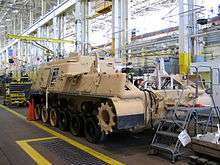
Today, although the city is surrounded by pecan groves, pine trees, farms and plantations, almost none of the population is employed in agriculture. It has become heavily industrialized, and most business is conducted on a multinational scale. The city developed on both sides of the Flint River.
Health care, education and the Marine Corps Logistics Base Albany are the largest employers. Manufacturing, transportation, and retail trade are also important foundations of Albany's economy, and the city acts as a hub for commerce in southwest Georgia.
On December 17, 2008, Cooper Tire and Rubber, one of Albany's largest employers, announced plans to close the local manufacturing facility. Approximately 1,400 employees at the plant were projected to lose their jobs.
Business environment
As a result of the recent economic downturn, unemployment remained higher in Albany than the country average. But in 2012 Albany continued to add more new jobs while other portions of the state were trying to stem the tide of joblessness. [37]
Albany has a skilled workforce, makes continual upgrades to its infrastructure, and has improvements in public safety, such as its ISO fire rating of 2.[38] It has numerous economic development initiatives, such as an Opportunity Zone, which offers a $3,500 tax credit per job created.[39]
Top non-government employers in Dougherty County
- AT&T
- Coats and Clark, Inc.
- Miller Brewing Company
- Phoebe Putney Memorial Hospital
- Procter & Gamble
- Teleperformance USA
- United Parcel Service
Companies
- Georgia Pacific Corp.
- Mars, Incorporated
- Mediacom
- Procter & Gamble
- Sherwood Pictures
- Thrush Aircraft
Arts and culture
| The manager of a local movie theater was convicted in Jenkins v. Georgia (1972) of "distributing obscene material" for showing the film Carnal Knowledge, a popular movie directed by Mike Nichols and starring Jack Nicholson, Art Garfunkel, Ann-Margret, and Candice Bergen. |
Museums and the arts
.jpg)
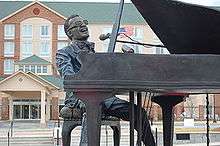
- Albany Area Arts Council[40]
- The Albany Chorale[41]
- Albany Civic Center
- Albany Civil Rights Institute[42]
- The Albany Concert Association[43]
- Albany Municipal Auditorium
- Albany Museum of Art[44]
- The Albany Symphony Orchestra[45]
- Art Park on Pine[46]
- Ballet Theatre South[47]
- Flint RiverQuarium[48]
- The Parks at Chehaw[49] has one of two accredited zoos in the state.
- RiverQuarium Imagination Theater[50]
- Theatre Albany[51]
- Thronateeska Heritage Center[52]
- Weatherbee Planetarium[53]
Registered historic places
- Albany District Pecan Growers' Exchange
- Albany Housefurnishing Company
- Albany Municipal Auditorium[54][55]
- Albany Railroad Depot Historic District
- Bridge House[56]
- Carnegie Library of Albany
- Davis-Exchange Bank Building
- John A. Davis House
- Mount Zion Baptist Church[57]
- New Albany Hotel[58]
- Old St. Teresa's Catholic Church
- Rosenberg Brothers Department Store
- St. Nicholas Hotel
- Samuel Farkas House
- Tift Park
- U.S. Post Office and Courthouse[59]
- Union Station Depot
- W. E. Smith House
Sports
- Albany was home to the Albany Polecats, who were a low-A class team that played in the South Atlantic League between 1992 and 1995. Albany was also home to the South Georgia Peanuts, who played in the South Coast League. They won the South Coast League championships in the league's inaugural season (2007) and were managed by former MLB shortstop Wally Backman. The league folded after that season.
- The Albany Panthers were an indoor football team based in Albany, Georgia. The team joined the Southern Indoor Football League (SIFL) during their inaugural season in 2010. When the SIFL folded, the team joined the Professional Indoor Football League in 2012. The Panthers' home games were played at the James H. Gray Civic Center until 2014.
- The Georgia Firebirds were an indoor football team that played in various semi-pro leagues as well as the professional American Indoor Football in 2016 and the National Arena League in 2017.
Memorials and sights
- Albany Civil Rights Memorial
- Albany Railroad Depot Historic District
- Astronauts Memorial
- Confederate Memorial Park
- The Flint Riverquarium
- Freedom Flame
- Freedom Walk
- The Guardian
- Radium Springs – one of the Seven Natural Wonders of Georgia
- Ray Charles Plaza
- RiverFront Park
- Royal Air Force Memorial
- Veterans Park
Festivals and events
City races include a 26.2-mile (42.2 km) full marathon or a 13.1-mile (21.1 km) half marathon. The full race is ranked as one of the top Boston Marathon qualifiers in the country, with almost 20% of all marathon finishers qualifying.[60]
The annual Mardi Gras Street Festival takes place in downtown Albany the first weekend of March. Starting at noon and running until midnight, the festival coincides with the marathon and half marathon.
Government
| The new federal courthouse in downtown Albany is dedicated in honor of the civil rights attorney C.B. King of Georgia. |
Elected officials include a mayor and six city commissioners, each of whom serves a four-year term. The commissioners are elected from single-member districts. An appointed city manager acts as the chief administrative officer. The city has been governed by a city commission and city manager since January 14, 1924.[61]
City departments include:
- Airport
- Albany Fire Department
- Albany Police Department
- Albany Transit System
- Central Services
- City Attorney
- Civic Center
- Code Enforcement
- Community and Economic Development
- Engineering
- Equal Employment Office (EEO)
- Finance Department
- Human Resources
- Information Technology
- Keep Albany Beautiful
- Municipal Court
- Planning and Development
- Public Works
- Recreation and Parks Department
Education
Public schools
The Dougherty County School System operates a system of five learning centers, sixteen public elementary schools, six public middle schools, and four public high schools. All schools are accredited by the Southern Association of Colleges and Schools (SACS) and the Georgia Accrediting Commission (GAC). The system had an enrollment in 2009–2010 of 15,838 students being taught by 1,070 teachers and 198 support and administrative personnel.[63]
The following schools have distinctions:
- Alice Coachman Elementary School: 2009 National Blue Ribbon School, 2009 "No Excuses School" (Georgia Public Policy Foundation)
- Lincoln Elementary Magnet School: 2009–2010 Governor's Office of Students Achievement Bronze Award for Highest Percentage of Students Meeting & Exceeding Standards on the CRCT
- International Studies Elementary Charter School: Title 1 Distinguished School (10 consecutive years making AYP)
- Robert A. Cross Middle Magnet School: 2009–2010 Governor's Office of Students Achievement Gold Award for Highest Percentage of Students Meeting & Exceeding Standards on the CRCT
Private schools
Several private schools provide primary and secondary education, including:
- Byne Memorial Baptist School (BMBS)
- Deerfield-Windsor School (DWS)
- Far Horizons Montessori School
- Life Christian School (Permanently closed as of 2013)
- God's Foundation Christian Academy (GFCA), formerly known as New Beginning Christian School (NBCS)
- St. Teresa's Catholic School (STS)
- Sherwood Christian Academy (SCA)
- Vertical High School Academy
- Young Unlimited Minds Institute (YUMI)
Higher education
Albany State University
The city is the location of Albany State University, founded as a pre-collegiate school in 1903. African Americans in the South had been intent since emancipation in gaining education and, by the turn of the 20th century, most were literate, as documented by W.E.B. Du Bois in his history, Black Reconstruction (1930). Albany State is notable as one of the few historically black colleges and universities to be part of the University System of Georgia.
Albany Technical College
Albany Technical College[64] is part of the Technical College System of Georgia and teaches post-secondary vocational and occupational training subjects.
Georgia Military College (GMC) has a site at this campus and conducts some classes here.
Troy University
Albany is a site location of Troy University, one of many satellites which Troy has established throughout the Southeastern United States. For more than 20 years, Troy University, a public non-profit institution of Alabama, has taught classes both in-class and online in Albany. Troy's Albany site has classes in criminal justice, psychology and various general studies, along with offering other undergraduate and master's degree programs online.[65]
Public libraries
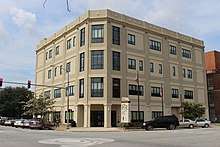
Dougherty County Public Library operates the public libraries serving Albany.
Media

Newspapers
- The Albany Herald, founded in 1891
- The Albany Journal,[66] published since 1939; Tom Knighton is current editor and publisher
- The Albany Southwest Georgian, historically black newspaper founded by A. C. Searles, editor[67]
- The Metro Gazette, offers positive news about the community; founded in 2010 by Judith Hampton-Thompson
Television stations
FM radio stations
- 88.5 W203AT (religious; translator for KEAR)
- 89.3 WBJY (religious)
- 90.3 WAEF (religious)
- 90.7 WWQA (religious, bluegrass)
- 91.7 WUNV (NPR – news, classical)[73]
- 92.7 WASU (Albany State University – college, jazz, urban)
- 93.1 WSRD (religious, talk)
- 93.5 WMRG (hip-hop/R&B) [74]
- 93.9 WMTM (Classic hits)
- 94.7 WDEC (hot adult contemporary)
- 96.3 WJIZ (urban)[75]
- 97.3 WGEX "Power 97.3" (Top 40)[76]
- 98.1 WMRZ "Kiss" (adult urban)[77]
- 100.3 WOBB "B-100"(country)[78]
- 101.3 WTOA-LP Catholic radio
- 101.7 WQVE "V101.7"(R&B, classic soul)[79]
- 102.1 WPFQ "102.1 Nash Icon" (country)[80]
- 102.5 W273AE (religious; translator for WYFK)
- 103.5 WJAD "Rock 103" (classic and mainstream rock) (Leesburg)[81]
- 104.5 WKAK "Nash FM" (country) (formerly K-Country 104.5 as of June 2013)[82]
- 105.5 WZBN "Power 105... The King" (holy hip hop and contemporary gospel)[83]
- 106.1 WHKV (Christian contemporary)
- 106.5 WZIQ (Christian)
- 107.7 WEGC "Mix 107.7" (adult contemporary)
AM radio stations
- 960 WJYZ (gospel)
- 1250 WSRA (ESPN sports)
- 1590 WALG (news, talk)
Infrastructure
Transportation
Air
Southwest Georgia Regional Airport (ABY) is a non-hub commercial service airport with service to Atlanta by ExpressJet, a regional carrier for Delta. Both UPS and DHL use the airport as a sorting facility. In 2010, a master plan was completed. It recommended moving forward with the Replacement Terminal Project.[84]
Rail
Freight rail service is provided by Georgia Southwestern Railroad, Georgia and Florida Railway/Omnitrax, and Norfolk Southern Railway. Georgia and Florida Railway has its headquarters in Albany.
Bus
Albany Transit System (ATS) has been operated by the city since 1974 and provides fixed-route and para-transit services in Albany and Dougherty County, including service to the airport. All buses are wheelchair accessible and are equipped with bicycle racks. The main transfer station is in downtown Albany, at the corner of Oglethorpe and Jackson.[85]
In addition, a Greyhound bus station is located in downtown Albany, with connections to interstate service.
Roads
Albany is located on Georgia State Route 300 (Georgia-Florida Parkway), which provides easy access to Cordele, and Interstate 75 to the northeast and south to Camilla, and Thomasville. The Liberty Expressway spans 10 miles (16 km) serves as a bypass on Albany's north and east sides. Other highways that pass through Albany include US 19, US 82, and State Routes 3, 62, 91, 133, 234, and 520.[86]
Bridges
Albany's historic Broad Avenue Memorial bridge was constructed in 1920 and comprises three open-spandrel concrete deck arch main spans, and eight closed-spandrel deck arch spans.[87] Because it is obsolete, deconstruction of the bridge was started in early 2013.
In the early 1970s, construction of the Liberty-bypass bridges began. Construction of the bridges over the Flint River was completed much before the highway itself. They became known as the bridges to nowhere.
Trivia
The intersection of Lonesome and Hardup was ranked as the fourth wackiest street intersection name, according to a 2006 poll by the Car Connection website.[88]
Energy infrastructure
Albany Water Gas and Light
Georgia Power
Portions of Albany are serviced by Georgia Power, which operates two electrical power plants within Dougherty County: coal-fired Plant Mitchell and the hydroelectric dam at Lake Worth,[89] also known as Lake Chehaw.
Water management infrastructure
The Albany Water, Gas & Light Commission (WG&L) is a municipally-owned and operated utility system furnishing water, gas, and electricity to its broad–based customers. Albany WG&L, was founded in 1892 as the Albany Water Works, as the largest municipal user in Georgia.[90]
The public water supply source for Albany-Dougherty County is groundwater obtained from four aquifers:
- Upper Floridan (locally called the Ocala) Aquifer
- Claiborne (formerly Tallahatta) Aquifer
- Clayton Formation
- Providence Aquifer
The water quality is considered to be excellent, needing only chlorination and fluoridation treatment.[91]
Communications infrastructure
Both WG&L and AT&T offer communications infrastructure within the City of Albany.[90]
Solid waste management
Albany is served by the Dougherty County Landfill located at 900 Gaissert Road, approximately 7.5 miles (12.1 km) southeast of the City of Albany.[92]
Health care
Albany is the home of a not-for-profit regional health system with a 26-county cachement area with Phoebe Putney Memorial Hospital[93] at its hub.
Public safety
Law enforcement
Albany is serviced by the Albany Police Department (APD) which is divided into three districts, each having its own police center. The Dougherty County Police Department is responsible for the unincorporated area of Dougherty County. The Dougherty County Sheriff's Department is a law-enforcement agency under the direction of the County Sheriff, an elected official.[94]
Fire protection
The Albany Fire Department consists of more than 150 assigned personnel operating 11 fire stations in Dougherty County, seven of which are within the city limits.[94]
EMS/EMT service
Dougherty County EMS has over 60 employees and services the county through one headquarters and five satellite stations.[94]
Notable people
- Paul McKinney: Pennsylvania State Senator for the 8th district from 1975 to 1982[95]
- Mary Francis Hill Coley: midwife in Albany 1930–1966, inducted into Georgia Women of Achievement 2011[96]
- Ray Charles
- Reginald D. Hunter, stand-up comedian
- Harry James: Swing era trumpet player and band leader
References
- "2018 U.S. Gazetteer Files". United States Census Bureau. Retrieved February 12, 2020.
- "Albany (city) QuickFacts from the US Census Bureau". Quickfacts.census.gov. Archived from the original on June 11, 2012. Retrieved April 14, 2012.
- "Population and Housing Unit Estimates". Retrieved June 4, 2019.
- "U.S. Census website". United States Census Bureau. Retrieved January 31, 2008.
- "US Board on Geographic Names". United States Geological Survey. October 25, 2007. Retrieved January 31, 2008.
- "Find a County". National Association of Counties. Archived from the original on May 31, 2011. Retrieved June 7, 2011.
- "Thronateeska Heritage Center". Heritagecenter.org. Retrieved August 27, 2017.
- Archived March 10, 2009, at the Wayback Machine
- Fair, John D. "Nelson Tift: A Connecticut Yankee in King Cotton's Court," Georgia Historical Quarterly (2004) 88#3 pp 338-374
- Jefferson Davis (March 12, 2012). The Papers of Jefferson Davis: 1871-1879. LSU Press. pp. 37–38. ISBN 978-0-8071-3907-3.
- Raymond B. Nixon (June 17, 1945). "Constitution's Founder Fought for Georgia with Pen and Sword". The Atlanta Constitution. Retrieved April 7, 2019.
- "AJC History: The Story of the Atlanta Journal-Constitution". The Atlanta Journal-Constitution. 2019. Retrieved April 7, 2019.
- "About The Constitution. (Atlanta, Ga.) 1868–1869". Chronicling America. Library of Congress. Retrieved January 18, 2011.
- "The Atlanta Constitution". Fishwrap. June 16, 2018. Retrieved June 16, 2018.
- "The Founders of the Atlanta Constitution at Oakland Cemetery". Historic Oakland Cemetery Foundation. June 18, 2018. Retrieved April 8, 2019.
- "Carey Wentworth Styles papers, 1860-1945". Emory University - Stuart A. Rose Manuscript, Archives, and Rare Book Library. Retrieved April 8, 2019.
- "Turner AFB". Archived from the original on May 13, 2006. Retrieved May 11, 2006.
- "1370th Photomapping and Charting Group". Archived from the original on May 17, 2006. Retrieved May 11, 2006.
- "History of Turner Field Albany Georgia". Archived from the original on May 24, 2006. Retrieved May 11, 2006.
- Center, Storm Prediction. "Storm Prediction Center Storm Reports Page". www.spc.noaa.gov.
- "Hurricane Michael Hits Georgia". National Weather Service. October 10, 2018.
- "Coronavirus US cases by County". New York Times. April 14, 2020.
- "P&G Toilet Paper Factory Keeps Delivering as Coronavirus Strikes Its Town". Wall Street Journal. April 17, 2020.
- "US Gazetteer files: 2010, 2000, and 1990". United States Census Bureau. February 12, 2011. Retrieved April 23, 2011.
- "accessed January 30, 2012". Georgiaencyclopedia.org. Retrieved April 14, 2012.
- "Tree City USA Directory - The Arbor Day Foundation". Arborday.org. Retrieved August 27, 2017.
- "Vegetation" (PDF). Albany.ga.us. Archived from the original (PDF) on February 22, 2014. Retrieved August 27, 2017.
- "City of Albany-Dougherty County Official Website - Arborist". November 5, 2011. Archived from the original on November 5, 2011.
- "City of Albany-Dougherty County Official Website - Recreation & Parks Dept". December 20, 2010. Archived from the original on December 20, 2010.
- https://web.archive.org/web/20140223110627/http://www.manta.com/c/mm4v26c/garden-club-center-federated
- "Riverfront Greenway Trail - Georgia Trails - TrailLink.com". Traillink.com. Retrieved August 27, 2017.
- "Albany, Georgia Köppen Climate Classification (Weatherbase)". Weatherbase. Retrieved August 27, 2017.
- "Average Weather for Albany, GA – Temperature and Precipitation". Weather.com. July 2011. Archived from the original on October 22, 2012. Retrieved August 27, 2010.
- "Census of Population and Housing". Census.gov. Retrieved June 4, 2015.
- Profile of General Population and Housing Characteristics: 2010 Demographic Profile Data , U.S. Census Bureau, 2010. Retrieved January 31, 2011.
- 2010 U.S. Census Bureau American Fact Finder Tables DP-1 Profile of General Population and Housing Characteristics, 2010 and DP03 Selected Economic Characteristics Accessed on January 31, 2012
- "accessed January 30, 2012". Albanyherald.com. January 21, 2012. Retrieved April 14, 2012.
- "Cost of Doing Business". choosealbany.com. 2015. Retrieved June 27, 2019.
- "accessed January 30, 2012". Dca.state.ga.us. Archived from the original on April 22, 2012. Retrieved April 14, 2012.
- "Arts Council - Rental - Albany Area Arts Council / Carnegie Library". Arts Council - Rental - Albany Area Arts Council / Carnegie Library. Retrieved August 27, 2017.
- "The Albany Chorale, Home of Albany Georgia's Community Chorus". albanychorale.org. Retrieved August 27, 2017.
- Administrator. "Welcome to the Albany Civil Rights Institute". Albanycivilrightsinstitute.org. Retrieved August 27, 2017.
- "Albany Concert Association". December 10, 2004. Archived from the original on December 10, 2004.
- "Albany Museum of Art". Albany Museum of Art. Retrieved August 27, 2017.
- "Albany Symphony Orchestra in Georgia". Albanysymphony.org. Retrieved August 27, 2017.
- "Artpark on Pine - Welcome to Artpark on Pine". Artpark on Pine. Archived from the original on November 15, 2016. Retrieved August 27, 2017.
- "Ballet Theatre South". Ballet Theatre South. Retrieved August 27, 2017.
- "Flint RiverQuarium - Home". Flintriverquarium.com. Retrieved August 27, 2017.
- "Chehaw in Albany GA". Chehaw.org. Retrieved August 27, 2017.
- "Flint RiverQuarium :: Albany, Georgia". July 6, 2008. Archived from the original on July 6, 2008. Retrieved August 27, 2017.
- Publishing, Lewis. "Welcome To Theatre Albany". Theatrealbany.com. Retrieved August 27, 2017.
- "Thronateeska Heritage Center". Heritagecenter.org. Retrieved August 27, 2017.
- "Thronateeska Heritage Center". Heritagecenter.org. Retrieved April 14, 2012.
- Archived June 30, 2007, at the Wayback Machine
- "Albany, GA : This picture is of the Albany police station downtown. User comment: I'm from Albany, Georgia, and this is not a picture of the Police Station downtown. This is a picture of the historic Albany Municipal Auditorium. photo, picture, image (Georgia) at". City-data.com. October 8, 2005. Retrieved April 14, 2012.
- "Archived copy". Archived from the original on July 6, 2006. Retrieved September 24, 2006.CS1 maint: archived copy as title (link)
- "Albany, GA : Albany Heights Building photo, picture, image (Georgia) at". City-data.com. May 29, 2006. Retrieved April 14, 2012.
- "Historic Buildings". W3.gsa.gov. June 22, 2010. Archived from the original on November 8, 2004. Retrieved April 14, 2012.
- "SNICKERS® Marathon and Half Marathon in Georgia". albanymarathon.com. Retrieved August 27, 2017.
- "Board on City Commissioners". Official City of Albany and Dougherty County Website. City of Albany, GA. Archived from the original on October 8, 2011. Retrieved October 11, 2011.
- "accessed January 30, 2012". Albany.ga.us. April 28, 2008. Archived from the original on May 11, 2012. Retrieved April 14, 2012.
- Dougherty County School System Archived March 23, 2010, at the Wayback Machine
- "Welcome to Albany Technical College". Albanytech.edu. Retrieved August 27, 2017.
- "troy.edu - TROY Service Centers". troy.edu. Retrieved August 27, 2017.
- thealbanyjournal.com Archived March 26, 2010, at the Wayback Machine
- Adam Fairclough, To Redeem the Soul of America: The Southern Christian Leadership Conference and Martin Luther King, Jr, University of Georgia Press, 2001, p. 100
- "Home". Walb.com. Retrieved August 27, 2017.
- "Masterpiece: Endeavour - Season Four". Gpb.org. Retrieved August 27, 2017.
- Group, Sinclair Broadcast. "Albany News, Weather, Sports, Breaking News - WFXL". Wfxl.com. Retrieved August 27, 2017.
- WCTV. "WSWG". Wswg.tv. Retrieved August 27, 2017.
- "WSST-TV 51 DT - WSST- DT 51 Home". Wsst51.com. Retrieved August 27, 2017.
- dvprez. "WUNV 91.7 FM". Ontheradio.net. Retrieved August 27, 2017.
- "Albany, GA Has A New Hip-Hop Station With WMRG (Streetz 93.5)". Allaccess.com. Retrieved August 27, 2017.
- "96.3 WJIZ - Albany's #1 for Hip Hop & R&B". 96.3 WJIZ. Retrieved August 27, 2017.
- "WGEX-FM – 97.3 – Hit Music NOW". 973hitmusicnow.com. Retrieved April 14, 2012.
- "98.1 Kiss FM - Albany's Station for Today's R&B & Jammin' Old School". 98.1 Kiss FM. Retrieved August 27, 2017.
- "B100 - Albany's #1 For New Country". B100. Retrieved August 27, 2017.
- "WQVE-FM". WQVE-FM. Retrieved August 27, 2017.
- "WNUQ-FM". WNUQ-FM. Retrieved August 27, 2017.
- "WJAD-FM". WJAD-FM. Retrieved August 27, 2017.
- "WKAK-FM". WKAK-FM. Retrieved August 27, 2017.
- "Wayback Machine". June 9, 2011. Archived from the original on June 9, 2011.
- "Southwest Georgia Regional Airport Master Plan Update". February 22, 2014. Archived from the original on February 22, 2014.
- "City of Albany-Dougherty County Official Website - Albany Transit Service". Albany.ga.us. Archived from the original on April 27, 2012. Retrieved August 27, 2017.
- "accessed January 30, 2012" (PDF). Archived from the original (PDF) on February 21, 2011. Retrieved April 14, 2012.
- "Broad Avenue Bridge". Bridgehunter.com. Retrieved April 14, 2012.
- See the entry for September 19 on Ben Scott, Schott's Miscellany Calendar 2009 (New York: Workman Publishing Company, 2008).
- Archived May 25, 2015, at the Wayback Machine
- "Partners - Albany-Dougherty Economic Development Commission". choosealbany.com. Retrieved August 27, 2017.
- "accessed January 30, 2012". Albany.ga.us. Archived from the original on November 9, 2012. Retrieved April 14, 2012.
- "(Chapter 5: Community Facilities) accessed January 30, 2012". Albany.ga.us. Archived from the original on November 9, 2012. Retrieved April 14, 2012.
- "Phoebe Putney". Phoebeputney.com. Retrieved August 27, 2017.
- (Chapter 5) retrieved 30, January 2012 Archived November 9, 2012, at the Wayback Machine
- "Pennsylvania State Senate - Paul McKinney Biography". www.legis.state.pa.us. Retrieved March 7, 2019.
- "Coley, Mary Francis Hill - Georgia Women of Achievement". February 15, 2012. Archived from the original on February 15, 2012.
Further reading
- Carolyn Clive, Frances Davis, and Tom Liner, eds., Glancing Backward: Albany, Georgia, 1836–1986 (Albany, Ga.: Dougherty County School System and Sesquicentennial Publication Committee, 1986).
- Lee W. Formwalt, "A Garden of Irony and Diversity," in The New Georgia Guide (Athens: University of Georgia Press, 1996).
- Joseph Winthrop Holley, You Can't Build a Chimney from the Top: The South through the Life of a Negro Educator (New York: William-Frederick Press, 1948).
- Thronateeska Chapter, Daughters of the American Revolution, History and Reminiscences of Dougherty County, Georgia (1924; reprint, Spartanburg, S.C.: Reprint Co., 1978).
- Works Progress Administration, Historical Background of Dougherty County, 1836–1940 (Atlanta: Cherokee, 1981).
External links
| Wikivoyage has a travel guide for Albany (Georgia). |
| Wikimedia Commons has media related to Albany, Georgia. |
- City of Albany official website
- South Georgia Historic Newspapers Archive Digital Library of Georgia
- Old U.S. Post Office and Courthouse
- Albany's First Brick House historical marker

- "Albany (Georgia)". New International Encyclopedia. 1905.
- "Albany". Encyclopædia Britannica (11th ed.). 1911.
- . Encyclopedia Americana. 1920.
- . Collier's New Encyclopedia. 1921.

